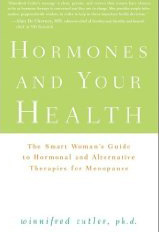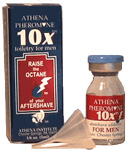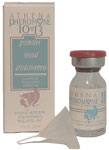
Chapter 3 - Prescription Hormones: How to Choose Them, How to Take Them
"Look Inside" Dr. Winnifred Cutler's essential book; an excerpt from Chapter 3 for readers.
Click here for full book description
Copyright © 2009 John Wiley & Sons, Inc.
Hormones and Your Health: The Smart Woman's Guide to Hormonal and Alternative Therapies for Menopause
Excerpted pages 30-31, 40
If you decide to explore the possibility of taking hormonal therapy, recognize two essential truths. First, hormones are powerful and should never be used without prescriptions from a physician who knows you, has examined you, and is monitoring your health. (And, of course, your doctor will tell you whether your medical history disqualifies you from using them.) Second, don’t buy a “natural hormone product” in a health food store. A clerk in this store is not licensed to advise you in such matters or to practice medicine. To take any hormone on your own is folly. It is dangerous. Don’t do it. Learning about your options will help you work effectively with your doctor to find an individualized regimen that is right for you.
The Essential Estrogens
Before you see your doctor for a prescription, take the time to read about what you’re trying to replace. Here’s what you should know.
Not All Estrogens Are Alike
Three major forms of estrogen circulate in your blood: estradiol, estriol, and estrone. Of the three, estradiol is the most active hormone, the one that researchers test in women. It’s also the choice for experiments on biological tissues. Estradiol produces measurable effects on every physiological system and body part on which it has been tested: bone, skin, brain, and sexual response. It is considered a strong estrogen because of that kind of wide-ranging power. (Estradiol in the body is found in two variants, like left- and right-handed, called 17a and 17b.) But estriol, considered the weak estrogen, also has some powerful effects: it reduces wrinkles on the face and can restore aging (technically, atrophic) vaginal skin (see pages 19-20). Think of the third estrogen, estrone, as the storage “reservoir tank” that can be measured from a sample of your blood. Experts who measure the biochemical conversions report that estrone and estradiol seem to continually convert back and forth, from one biochemical form into the other. Perhaps they convert from estrone storage into the active form of estradiol, as needed by the body. You might call it a bit of shape-shifting magic by Mother Nature.
***
Different Delivery Routes, Different Effects of Estrogen Products
The differences among prescribed estrogen products in potency and their varying effects on your physiology depend on their chemical structure and how they are delivered into your bloodstream. Delivery routes include injection, swallowing a capsule or a tablet, applying a skin patch, smoothing gel or cream onto your skin, or inserting a vaginal pill. You can also place a hormone tablet under your tongue or between your gum and your cheek, where it melts and is absorbed into the tiny blood capillaries nearby. Eventually, every route brings the hormone into your bloodstream for distribution throughout the entire body.714 These variations affect the way estrogens influence breast tissue, sexual and mental function, and lipid changes (such as potentially elevating harmful triglyceride levels—but only if you take an oral form).
***
If you want to try a vaginal route for some or all of the estrogen therapy your doctor prescribes, tell your doctor your preference. The FEMring provides doses that will raise your blood levels of estrogen, unlike the low-dose ESTring. You might find that a liquefying tablet is less intrusive than an inserted rubber device. So might your sex partner.
What You Should Know about All Delivery Routes
The delivery route that you will keep using is your best choice. And you can test each one before you choose. You can exert control over the delivery system you use. You insert, apply, or swallow. Most estrogen regimens are used every single day, all through the month.
Side effects are generally trivial and usually disappear after women adjust to—or modify—their regimens. But if you take a hormone that continues to cause nausea or pain, listen to this signal. Breast pain usually resolves by lowering the dose of estrogen or skipping a day. But other types of pain or discomfort should signal you to ask your doctor for a different regimen. Never take a regimen that makes you feel ill! Hormones should help you feel good.
Also in this chapter:
- The Powerful Progesterone
- What You Should Know About Sequential Hormone Therapy
- Labelling; Synthetic vs. Bioidentical (defining the terms)
END OF EXCERPT
Dr. Cutler's pheromone science has been "bottled" into vials of unscented fragrance additives that increase wearers' sexual attractiveness. AVAILABLE FOR PURCHASE HERE

